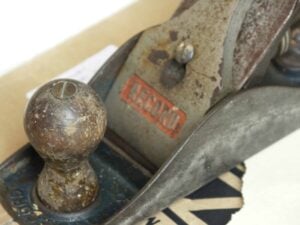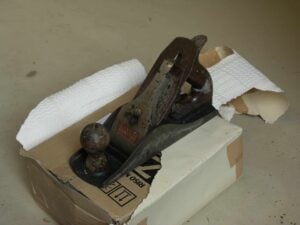Buying bench planes on eBay
For more information on planes, see our beginner site Common Woodworking.
I’ve bought dozens of planes on eBay over the years, rarely if ever with any mishaps. I thought it might help to know what I look for beyond the usual ratings and protection systems as standard.

I have bought 10 #4 1/2s for my offering over this series via eBay. Few will get by without some necessary corrective surgery and they are either Record or Stanleys.
1:
On the description I look for the sellers knowledge to see what status they are-professional eBay seller or simply a homeowner selling their stuff. The signs are obvious. I am also looking for someone who was a heavy user of the plane but really cared for it. A joiner, cabinet (furniture) maker or some professional woodworker, which includes all who don’t do it for a living, not those who only do it for money.
2:
The photos give lots of good info to back up descriptions: Firstly on this, I do not want to have to retrofit handles, knobs, cap irons, lever caps or cutting irons unless I have an odd plane to cannibalize parts from.
3:
Split knobs should be obvious, but ask if in doubt. Rarely do glued-up handles last, but they do sometimes. I have found that rosewood totes don’t glue well at all unless you use special glues, which again adds extra unnecessary cost to your purchase.
4:
Look especially at the length of the protruding cutting iron above the rear tote. Compare it to one you have or another on eBay to see how the length compares. The one shown here has plenty of iron length and will be good one to compare to. New irons can cost £9 +. It may still be a good price.
5:
Try to identify all the parts to make sure they are original. It’s best of they are.
6:
I must say I really like the rosewood handles better than beech because the feel good in the hand, especially older ones. I’ll pay a bit extra for this.
7:
Notice on this plane that the overall condition looks a little rough. That didn’t bother me at all. I could see before I bought it that it had lots of cutting iron, the handles were in good shape though a bit tatty, and that the rust was superficial, which as we know serves as a surface protection to deepening rust. Like the difference between painted and non-painted gates here in North Wales.
8:
There is no way to determine flatness of sole so it’s a given that you will have to work it some. Remember that buying a joiner’s plane will be slightly different than the furniture makers. The joiners plane was used to plane doors and so wer on the sole is usually along the length of the plane creating a channel down the length. Cabinet makers on the other hand plane wide boards and the plane will tend to be more bellied. Because the fore part hits roughness first and so wears that area.
9:
The handles need have no finish on them to appeal to me. I usually take off any finish and apply two or three coats of boiled linseed oil until my own sweat permeates, oils and seal the surface permanently through honest work.
10:
Greasy, oily looking planes don’t bother me either. I find the well-oiled metal parts form overly exuberant engineer woodworkers are usually rust free. degreasing takes only a minute.
11:
Nickel- or chrome-plating patchy with rust or missing altogether doesn’t bother me. I sand any edges flush, remove any loose plating and apply oil or furniture wax. It does not affect the function of plane.
12:
Paint inside the sole missing. Forget it and get on with the restoration. You can treat any rust and repaint if you like. Use a rust inhibiter to retard the rust development.
13:
Next comes the frog of the plane. The part you can’t see. No real advice on this. You could ask the seller for a pic but he’ll likely ignore you cos he can’t be bothered or he doesn’t know a frog from a toad.
The frog is the central adjustment unit that carries and controls all of the cutting assembly adjustments. Bailey’s or Bedrocks, both work fine. Not many Bedrocks on eBay any more. There’s plenty of Baileys around so don’t get hung up on Bedrocks when Baileys work just great.
Hope all this helps. Do the same with all of the bench planes and you won’t go far wrong.
Any questions I’ll try to help.



I would like to collect [SW] planes. How can I tell if a plane is SW on not? I see SW on the iron but is it just put there for sale. Can you help me some?
Hi Paul,
I recently found an old Stanley bailey no7 plane at a flee market, the plane is in its original box and has never been used, its in mint condition and has the original tags and booklet with it. I was wondering if i should set it up and use it or keep it clean given i haven’t seen many examples this clean.
All the best and thank you for sharing your knowledge, I’ve learned a ton from your internet content.
Tomás
Personally I am a user-man so I would set it up for using. Alternatively, if you wanted a No 7, you could buy a used one.